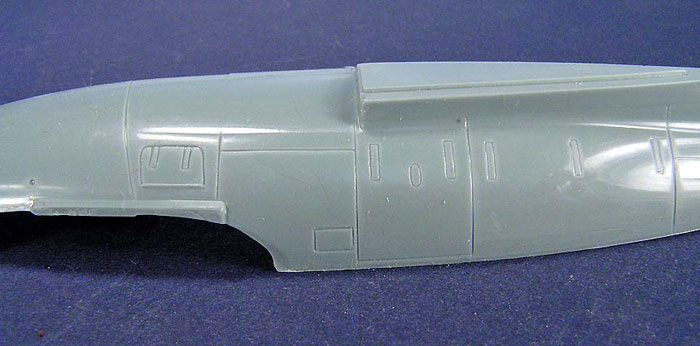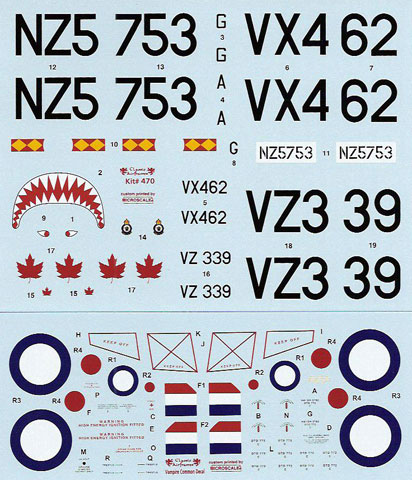|
De Havilland
Vampire FB Mk. 5

Classic Airframes
S
u m m a r y
|
| Catalogue Number: |
470 - De Havilland Vampire FB Mk. 5 |
| Scale: |
1/48 |
| Contents and Media: |
42 parts in gray styrene, 13 parts in gray colored
resin and 2 clear injection molded parts. Instructions, decal sheet and
painting guide for 3 aircraft. |
| Price: |
MSRP
USD$45.00 |
| Review Type: |
FirstLook |
| Advantages: |
Fine panel lines, highly detailed cockpit
sidewalls, crisply printed decals. |
| Disadvantages: |
|
| Recommendation: |
Highly Recommended |
Reviewed by Steven "Modeldad" Eisenman

Classic
Airframes' 1/48 scale Vampire FB Mk. 5 may be ordered online from Squadron
We have arrived at an interesting milestone in
modeling, for it appears that one model company is issuing new kits in
1/48 scale faster then the average modeler is capable of building them.
Classic Airframes has released kits of the Fiat CR.
42 and the Westland Wyvern since the second week in December 2004.
Today, less than two months later, on 2 February,
Groundhog Day, I received the De Havilland Vampire. If
Punxsutawney
Phil* is correct, and we do indeed have six more weeks of winter,
there are certainly enough new kits to build during those remaining long
cold nights and weekends.
Upon opening the box, I was immediately struck by
the fact that the color of the plastic is the same as that in the Wyvern
kit. But the similarity ends there. First, the panel lines are much
finer than the Wyverns, while still being sharp. These appear to be
“Goldilocks” panel lines. In many of the older kits they were too fine.
In the Wyvern, they seemed a bit too prominent. But in this kit, they
seem just right.

Click
the thumbnails below to view larger images:
The second thing I noticed was the cockpit
sidewalls. While the Wyvern’s were quite basic, the Vampire’s are
beautifully detailed. Once again, the control column is cast as an
integral part of the cockpit. Given the two-part canopy, the cockpit can
be shown off quite nicely. As with the Wyvern’s canopy, a dip in Future
will improve the clarity.

Click
the thumbnails below to view larger images:
There is no doubt that this kit was designed so
that the maximum number of Vampire variants could be developed. The
booms, wing tips and center fuselage are molded as separate components.
This kit includes both the flat and rounded wing tips.
A few random observations: There are not many
accessories included, just a pair of under wing tanks. The wheel wells
have a very thin pour stub. Also, there is a depression around the wheel
well opening in the wing in which the resin well sits. But, even with
that, it appears that some sanding of the wheel well tops will be
required to get the wing halves to go together. The tail booms are not
mere butt joints to the wings. The booms and wings were designed such
that the booms have a lip that fits into the opening of the wing. A
test fit shows that a little careful trimming of the opening in the wing
will allow for a very good fit.
The kit contains markings for three different
aircraft and a set of stencils. The artwork for and printing of the
decals appears particularly well done. The stenciling is quite legible
and the Canadian maple leafs are very sharp in outline.

Click
the thumbnails below to view larger images:
Markings are supplied for:
FB.5 - No. 112 Squadron RAF, VX462 / A*G RAF
Fassberg, Germany, circa 1952.
This was an experimental scheme of PRU Blue with a
disruptive application of Dark Green over the top surfaces. This scheme
has already been commented on in Plane Talking. The scheme was taken
from a profile in Warpaint Series No. 27. But upon looking through the
monograph, I noticed a faded color picture on page 16. I suggest that
the aircraft in the picture appear to be in the same scheme. The upper
surface appears to be too light to be Dark Sea Grey. Also, there is
little evidence of an upper-lower dividing line, which would have cut
across the lower portion of the roundel and on the nose.
FB. 9 – No. 75 Squadron, RNZAF, NZ5753, circa 1953.
The aircraft has Dark Green and Dark Sea Grey upper
surfaces with an underside in Aluminum (Speed Silver?). The FB. 9
differed from the FB. 5 in that it was intended for use in hot climates
and had a Godfrey refrigeration unit installed in the starboard/right
intake . This resulted in an eight inch fillet forward extension on the
intake. The kit does not seem to provide for this. In 1/48 scale, this
would amount to a three-sixteenths extension (approx. 4.76 mm).
FB. 5 – No. 421 Squadron, RCAF, VZ339, United Kingdom, circa 195.
This aircraft is in an overall Aluminum (Speed
Silver?) finish.
One could criticize Classic Airframes for focusing
too much on British aircraft. But, while the Vampire was a British
product, in its various forms it served in air forces around the world;
from Latin American air forces, to Denmark, Iraq and even Japan. Given
the number of Vampire variants that theoretically could be issued, one
could amass quite a collection of Vampires, each with a different set of
national markings.
I look forward to spending a few of those remaining
winter nights working on the FB. 5 of No. 112 Squadron. I’ll set it
along side my shark mouthed Tomahawk and Warhawk.
Highly Recommended.
Warpaint Series No. 27, de Havilland Vampire, by W. A. Harrison,
published by Hall Park Book LTD.
*
http://www.groundhog.org/
Thanks to
Classic Airframes for
the review sample.
Classic Airframes
kits are available worldwide through hobby retailers and from
Squadron.com
Review and Images Copyright © 2005 by
Steven "Modeldad" Eisenman
Page Created 03 February, 2005
Last updated 22 February, 2005
Back to HyperScale Main Page
Back to Reviews Page
|
Home | What's
New | Features
| Gallery |
Reviews | Reference
| Forum
| Search